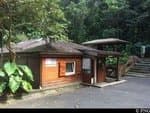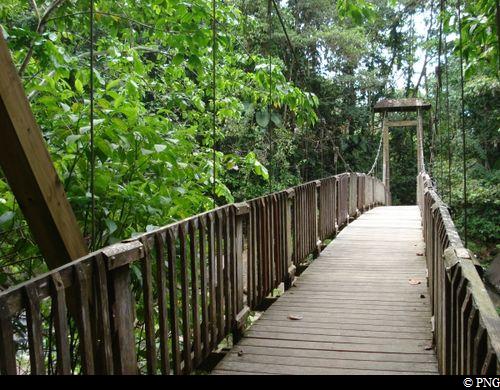
Maison de la Forêt trail
12 points of interest
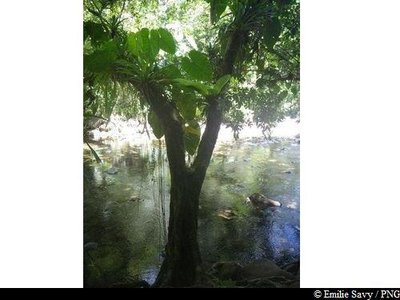
Pois Doux Petites Feuilles - Emilie Savy / PNG  Flora
FloraInga laurina
Inga laurina grows to around 15 metres tall. A tree with numerous branches, its flowers form a sort of white catkin. Its fruits are swollen pods containing seeds and a white, edible pulp.

sève de Gommier blanc - admin  Flora
FloraGommier
The Gommier (Daryodes excelsa) can grow up to 35m high. When they are damaged, its white trunk and roots exude a white resin with a pungent turpentine smell, which is traditionally used as incense or to start fires, because it burns slowly regardless of the surrounding humidity. It is reported that the tree has the ability to cast out spirits. It is strictly forbidden to take away any plant parts from the National Park. Its trunk was used by American Indians to make their canoes (kanawa), and is still used today by coastal people from many tropical countries, such as Dominique, to make fishing vessels. Its green seeds are popular with pigeons.

Bois Bréziyèt - admin  Flora
FloraSwartzia caribaea
A member of the Caesalpininiaceae family, Swartzia caribaea is a medium-sized tree that is found in rainforests and that thrives along rivers. It produces fleshy and leathery fruits that are somewhere between bright orange and yellowish-brown in colour.
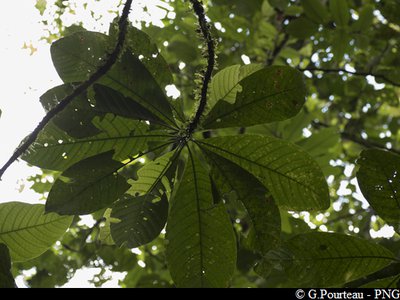
feuilles de Résolu - PNG  Flora
FloraChimarrhis cymosa
A member of the Rubiaceae family, Chimarrhis cymosa features yellow-orange coloured wood.
Its straight trunk is covered in a clear and smooth bark. Its leaves are light green, wide and long. Flowering occurs between April and May and between October and November, when the top of the tree is covered in white flowers. Its wood is renowned for its durability and is used to make hut flooring.
Palétuvier jaune - PNG  Flora
FloraSymphonia globulifera
A member of the Clusiaceae family, Symphonia globulifera is a tree that is often found in the rainforest or in swampy forest areas. Reaching up to 25-30 metres in height, it has stilt roots and a yellow latex trunk. Its flowers feature bright red petals, with oval fruits resembling nutmeg and that are yellow when ripe. It wood was used as timber for houses while its latex resin was used in boat-making.
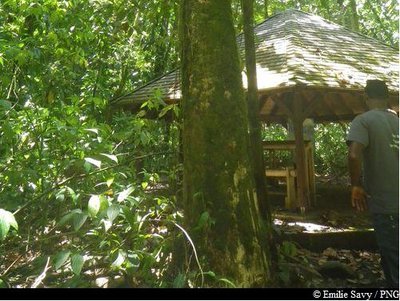
Mapou baril - Emilie Savy / PNG  Flora
FloraSterculia caribea
Sterculia caribea is endemic to the Lesser Antilles. Depending on the age of the plant, its leaves tend to vary in shape. Its fruits generally cluster together in groups of four or five woody follicles and are highly distinctive: they are lined on the inside with dark red urticating bristles. Its flowers appear in the form of a bunch of small yellow and pink bells.
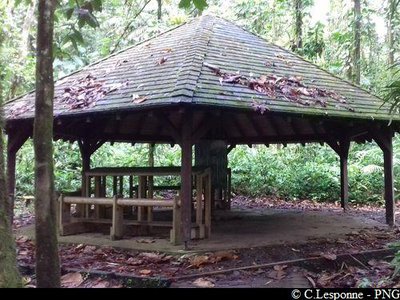
PNG  Area of relaxation
Area of relaxationCarbets (wooden shelters)
These large traditional carbets offer shelter and the chance to enjoy the sounds of the rainforest. These traditional Native American structures are made from wood and have no outer walls.
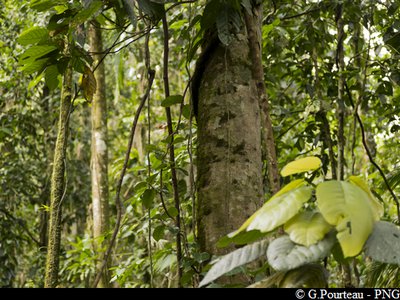
PNG  Flora
FloraSimarouba amara
A member of the Simaroubaceae family, Simarouba amara is a tree with straight and bare trunk that can grow up to 30 metres tall. It has smooth and whitish bark. Its leaves measure 60cm long and its greenish flowers are visible between April and July. Its wood is used in woodworking to make interior furniture parts.
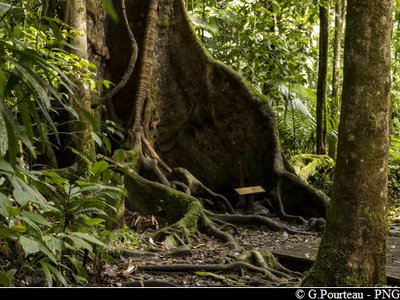
Acomat Boucan - PNG  Flora
FloraAcomat boucan
A member of the Elaeocarpaceae family, Sloanea caribaea is a very large tree that grows up to 40 metres tall. It is the most spectacular tree in the Sloanea genus. It has an exposed trunk and magnificent buttresses. Its bark is reddish-brown and tends to flake off in thin strips when the tree ages. Formerly, visitors to the forest would make us of its enormous buttresses to shelter their fires and to smoke meat. It has since been established that lighting fires among the roots is not conducive to the well-being of trees.
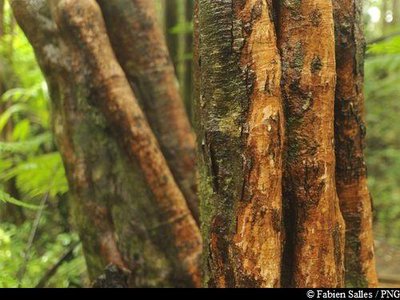
Bois cotelette noir (détail du tronc) - Fabien Salles / PNG  Flora
FloraTapura latifolia
Tapura latifolia, a member of the Melastomaceae family, is a tree that seldom grows beyond 20 metres. It features a fluted trunk and leaves marked by five main longitudinal veins running perpendicular to its many secondary veins.
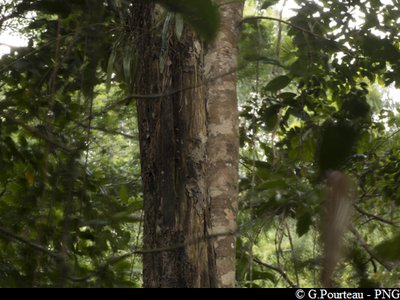
Bois diable (écorce) - PNG  Flora
FloraBois diable (Devil's wood)
The Bois diable is a rare tree : it can grow up 15 metres high and the diameter of its trunk is 60cm. Its roots grow from unspectacular buttresses. Its dark bark takes on a burnt-like quality and comes off in patches. It produces green, spherical fruits that contain a black flesh and flattened seeds. Be careful though, these fruits are poisonous! They were once used to stun river fish in order to catch them more easily. Also known in Créole as "Bré-bré", the wood of this tree is used to make fences, because it tends to rot slowly.

Châtaignier petites feuilles - Emilie Savy / PNG  Flora
FloraSloaena massoni
This small-leaved chesnut tree (Sloaena massoni) can grow between 20-40 metres tall. It has some very impressive buttresses with a number of branches. It boasts thick foliage and a crown that is quite spread out. Its leaves are 20-30 cm, which distinguishes it from the larger-leaved chestnut tree variety. It produces hard and round nuts that are covered with small, reddish and supple spines.
Description
Hiking trail colour: yellow
The trail begins just next to Maison de la Forêt, which is open to the public (see opening hours).
There is a special pamphlet about this trail, which will be updated soon.
Climb the stairs, cross the suspension bridge over the river Bras David and then turn left. At the intersection, turn right to follow the botanical discovery trail (or turn left to prolong the circular trail). Cross the first small bridge and then the next. At the hut, go straight on. Go back down the stairs.
When you reach the intersection at the start, turn left on the bridge to return to the Maison de la Forêt parking area. Feel free to enjoy the rest area at the Maison de la Forêt top parking area.
- Departure : Maison de la Forêt, Petit-Bourg
- Arrival : Maison de la Forêt, Petit-Bourg
- Towns crossed : Petit-Bourg
Altimetric profile
Recommandations
Pay attention to cars on Route RD23, as it is a major road.
There are no litter bins on the route, so please be considerate and take your rubbish with you.
Extra care should be taken in this natural environment, as Guadeloupe is prone to natural risks. For the benefit of all hikers, it is very important that you behave responsibly.
Please note: the parking and swimming areas are not supervised.
Information desks
Maison de la Forêt
RD 23 - Route de la Traversée, 97170 Petit-Bourg
Opening hours :
- In low season (May 1 to June 30 and September 1 to October 31) : every day (except weekends) from 9 am to 4.30 pm.
- In high season (November 1 to April 30 and from July 1 to August 31) : every day from 9 am to 4.30 pm ; sunday from 9 am to 12.30 pm.
Services: reception, permanent exhibition, free parking. Building and restrooms accessible to people with reduced mobility. Picnic area nearby.
Please note : parkings are not supervised.
Localisation GPS : Lat: 16,17600 N - Lng: 61,69280 W.
Access and parking
GPS coordinates of the start point : Lat : 16,17600 N - Long : 61,69280 W.
From Bouillante or Petit-Bourg: take Route de la Traversée (RD23). Stop at one of the two Maison de la Forêt parking areas.
Parking :
Accessibility
Forest House: building and restrooms accessible to people with reduced mobility.
Bras David Picnic Area - Forest House (Route de la Traversée (RD23): reserved parking, facilities to facilitate walking and wheelchair access (access ramp), and a shelter reserved for people with disabilities.
Corossol Picnic Area (at the end of the Corossol forest road, 1 km from the RD23): reserved parking, facilities to facilitate walking and wheelchair access (access ramp, renovated in July 2023), and two shelters reserved for people with disabilities.
- Emergency number :
- 114
- Advice :
09/2023: The Maison de la Forêt (Forest House) is offering a new exhibition highlighting the natural, cultural and landscape heritage of this emblematic forest for Guadeloupe.
More information
Source
Report a problem or an error
If you have found an error on this page or if you have noticed any problems during your hike, please report them to us here:

